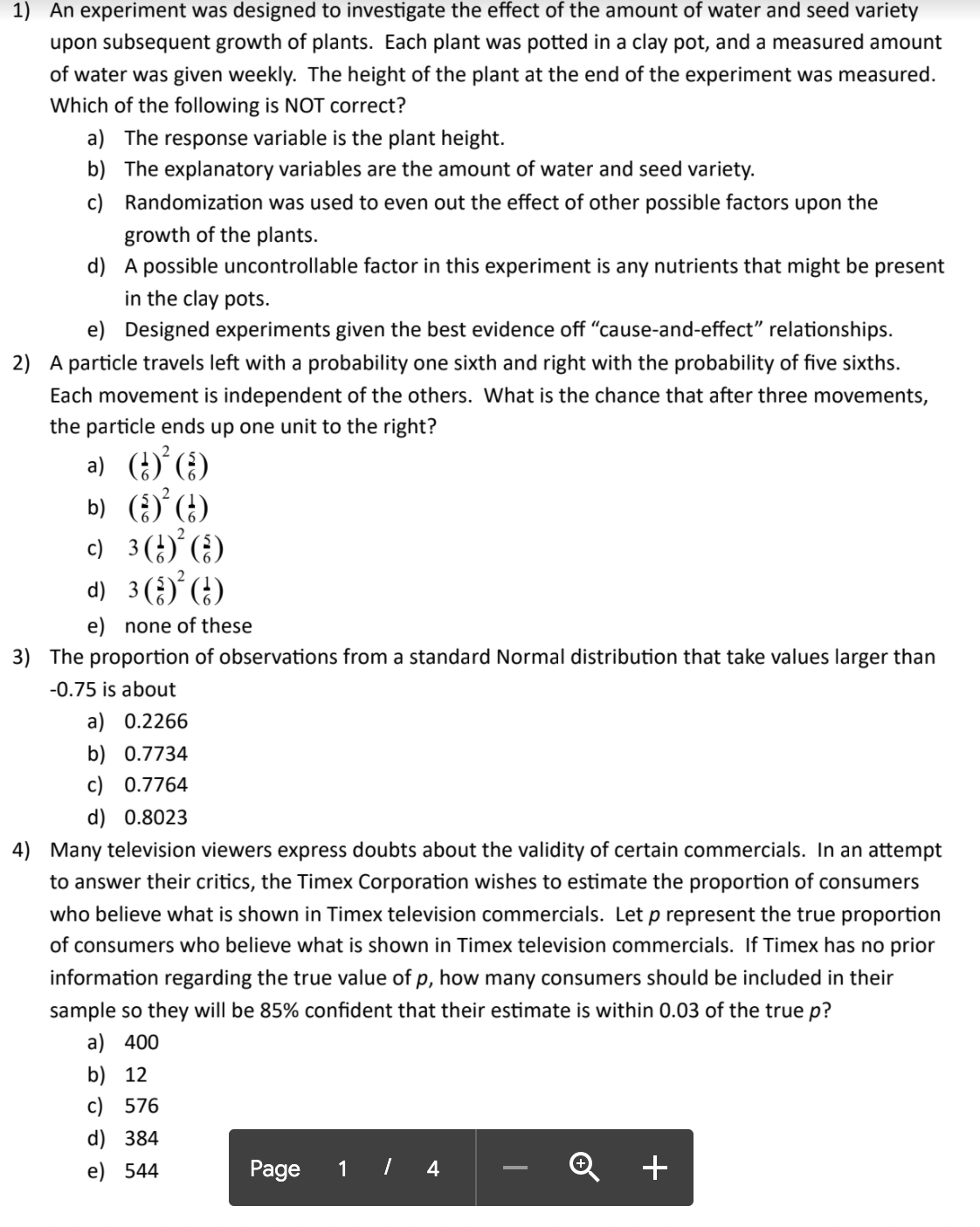1) An experiment was designed to investigate the effect of the amount of water and seed variety upon subsequent growth of plants. Each plant was potted in a clay pot, and a measured amount of water was given weekly. The height of the plant at the end of the experiment was measured. Which of the following is NOT correct? a) The response variable is the plant height. b) The explanatory variables are the amount of water and seed variety. c) Randomization was used to even out the effect of other possible factors upon the growth of the plants. d) A possible uncontrollable factor in this experiment is any nutrients that might be present
1) An experiment was designed to investigate the effect of the amount of water and seed variety upon subsequent growth of plants. Each plant was potted in a clay pot, and a measured amount of water was given weekly. The height of the plant at the end of the experiment was measured. Which of the following is NOT correct? a) The response variable is the plant height. b) The explanatory variables are the amount of water and seed variety. c) Randomization was used to even out the effect of other possible factors upon the growth of the plants. d) A possible uncontrollable factor in this experiment is any nutrients that might be present
Holt Mcdougal Larson Pre-algebra: Student Edition 2012
1st Edition
ISBN:9780547587776
Author:HOLT MCDOUGAL
Publisher:HOLT MCDOUGAL
Chapter11: Data Analysis And Probability
Section: Chapter Questions
Problem 8CR
Related questions
Topic Video
Question
Please answer 1-4.

Transcribed Image Text:1) An experiment was designed to investigate the effect of the amount of water and seed variety
upon subsequent growth of plants. Each plant was potted in a clay pot, and a measured amount
of water was given weekly. The height of the plant at the end of the experiment was measured.
Which of the following is NOT correct?
a) The response variable is the plant height.
b) The explanatory variables are the amount of water and seed variety.
c) Randomization was used to even out the effect of other possible factors upon the
growth of the plants.
d) A possible uncontrollable factor in this experiment is any nutrients that might be present
in the clay pots.
e) Designed experiments given the best evidence off "cause-and-effect" relationships.
2) A particle travels left with a probability one sixth and right with the probability of five sixths.
Each movement is independent of the others. What is the chance that after three movements,
the particle ends up one unit to the right?
a) ()'()
b) ()°(?)
c) 3(;)°(¿)
d) 3()'()
e) none of these
3) The proportion of observations from a standard Normal distribution that take values larger than
-0.75 is about
a) 0.2266
b) 0.7734
c) 0.7764
d) 0.8023
4) Many television viewers express doubts about the validity of certain commercials. In an attempt
to answer their critics, the Timex Corporation wishes to estimate the proportion of consumers
who believe what is shown in Timex television commercials. Let p represent the true proportion
of consumers who believe what is shown in Timex television commercials. If Timex has no prior
information regarding the true value of p, how many consumers should be included in their
sample so they will be 85% confident that their estimate is within 0.03 of the true p?
a) 400
b) 12
c) 576
d) 384
e) 544
Page
1 / 4
+
Expert Solution
This question has been solved!
Explore an expertly crafted, step-by-step solution for a thorough understanding of key concepts.
This is a popular solution!
Trending now
This is a popular solution!
Step by step
Solved in 2 steps

Knowledge Booster
Learn more about
Need a deep-dive on the concept behind this application? Look no further. Learn more about this topic, statistics and related others by exploring similar questions and additional content below.Recommended textbooks for you

Holt Mcdougal Larson Pre-algebra: Student Edition…
Algebra
ISBN:
9780547587776
Author:
HOLT MCDOUGAL
Publisher:
HOLT MCDOUGAL

College Algebra (MindTap Course List)
Algebra
ISBN:
9781305652231
Author:
R. David Gustafson, Jeff Hughes
Publisher:
Cengage Learning

Holt Mcdougal Larson Pre-algebra: Student Edition…
Algebra
ISBN:
9780547587776
Author:
HOLT MCDOUGAL
Publisher:
HOLT MCDOUGAL

College Algebra (MindTap Course List)
Algebra
ISBN:
9781305652231
Author:
R. David Gustafson, Jeff Hughes
Publisher:
Cengage Learning